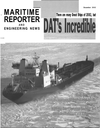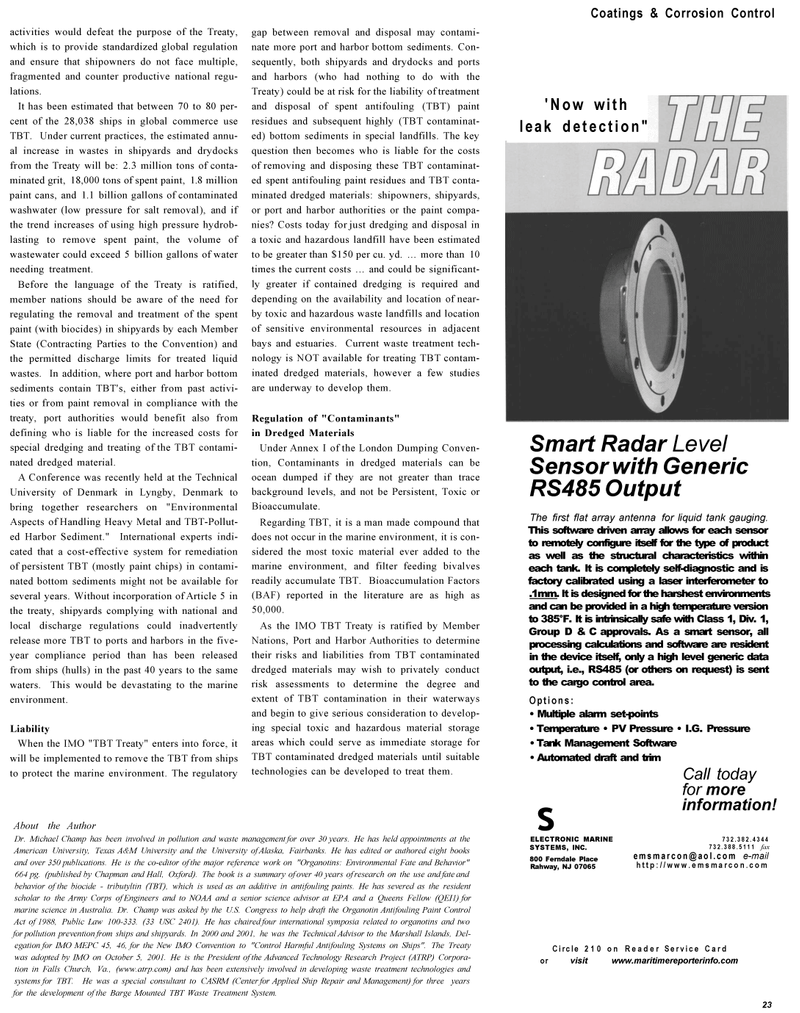
Page 23: of Maritime Reporter Magazine (December 2002)
Read this page in Pdf, Flash or Html5 edition of December 2002 Maritime Reporter Magazine
Coatings & Corrosion Control activities would defeat the purpose of the Treaty, which is to provide standardized global regulation and ensure that shipowners do not face multiple, fragmented and counter productive national regu- lations.
It has been estimated that between 70 to 80 per- cent of the 28,038 ships in global commerce use
TBT. Under current practices, the estimated annu- al increase in wastes in shipyards and drydocks from the Treaty will be: 2.3 million tons of conta- minated grit, 18,000 tons of spent paint, 1.8 million paint cans, and 1.1 billion gallons of contaminated washwater (low pressure for salt removal), and if the trend increases of using high pressure hydrob- lasting to remove spent paint, the volume of wastewater could exceed 5 billion gallons of water needing treatment.
Before the language of the Treaty is ratified, member nations should be aware of the need for regulating the removal and treatment of the spent paint (with biocides) in shipyards by each Member
State (Contracting Parties to the Convention) and the permitted discharge limits for treated liquid wastes. In addition, where port and harbor bottom sediments contain TBT's, either from past activi- ties or from paint removal in compliance with the treaty, port authorities would benefit also from defining who is liable for the increased costs for special dredging and treating of the TBT contami- nated dredged material.
A Conference was recently held at the Technical
University of Denmark in Lyngby, Denmark to bring together researchers on "Environmental
Aspects of Handling Heavy Metal and TBT-Pollut- ed Harbor Sediment." International experts indi- cated that a cost-effective system for remediation of persistent TBT (mostly paint chips) in contami- nated bottom sediments might not be available for several years. Without incorporation of Article 5 in the treaty, shipyards complying with national and local discharge regulations could inadvertently release more TBT to ports and harbors in the five- year compliance period than has been released from ships (hulls) in the past 40 years to the same waters. This would be devastating to the marine environment.
Liability
When the IMO "TBT Treaty" enters into force, it will be implemented to remove the TBT from ships to protect the marine environment. The regulatory gap between removal and disposal may contami- nate more port and harbor bottom sediments. Con- sequently, both shipyards and drydocks and ports and harbors (who had nothing to do with the
Treaty) could be at risk for the liability of treatment and disposal of spent antifouling (TBT) paint residues and subsequent highly (TBT contaminat- ed) bottom sediments in special landfills. The key question then becomes who is liable for the costs of removing and disposing these TBT contaminat- ed spent antifouling paint residues and TBT conta- minated dredged materials: shipowners, shipyards, or port and harbor authorities or the paint compa- nies? Costs today for just dredging and disposal in a toxic and hazardous landfill have been estimated to be greater than $150 per cu. yd. ... more than 10 times the current costs ... and could be significant- ly greater if contained dredging is required and depending on the availability and location of near- by toxic and hazardous waste landfills and location of sensitive environmental resources in adjacent bays and estuaries. Current waste treatment tech- nology is NOT available for treating TBT contam- inated dredged materials, however a few studies are underway to develop them.
Regulation of "Contaminants" in Dredged Materials
Under Annex I of the London Dumping Conven- tion, Contaminants in dredged materials can be ocean dumped if they are not greater than trace background levels, and not be Persistent, Toxic or
Bioaccumulate.
Regarding TBT, it is a man made compound that does not occur in the marine environment, it is con- sidered the most toxic material ever added to the marine environment, and filter feeding bivalves readily accumulate TBT. Bioaccumulation Factors (BAF) reported in the literature are as high as 50,000.
As the IMO TBT Treaty is ratified by Member
Nations, Port and Harbor Authorities to determine their risks and liabilities from TBT contaminated dredged materials may wish to privately conduct risk assessments to determine the degree and extent of TBT contamination in their waterways and begin to give serious consideration to develop- ing special toxic and hazardous material storage areas which could serve as immediate storage for
TBT contaminated dredged materials until suitable technologies can be developed to treat them.
About the Author
Dr. Michael Champ has been involved in pollution and waste management for over 30 years. He has held appointments at the
American University, Texas A&M University and the University of Alaska, Fairbanks. He has edited or authored eight books and over 350 publications. He is the co-editor of the major reference work on "Organotins: Environmental Fate and Behavior" 664 pg. (published by Chapman and Hall, Oxford). The book is a summary of over 40 years of research on the use and fate and behavior of the biocide - tributyltin (TBT), which is used as an additive in antifouling paints. He has severed as the resident scholar to the Army Corps of Engineers and to NOAA and a senior science advisor at EPA and a Queens Fellow (QEI1) for marine science in Australia. Dr. Champ was asked by the U.S. Congress to help draft the Organotin Antifouling Paint Control
Act of 1988, Public Law 100-333. (33 USC 2401). He has chaired four international symposia related to organotins and two for pollution prevention from ships and shipyards. In 2000 and 2001, he was the Technical Advisor to the Marshall Islands, Del- egation for IMO MEPC 45, 46, for the New IMO Convention to "Control Harmful Antifouling Systems on Ships". The Treaty was adopted by IMO on October 5, 2001. He is the President of the Advanced Technology Research Project (ATRP) Corpora- tion in Falls Church, Va., (www.atrp.com) and has been extensively involved in developing waste treatment technologies and systems for TBT. He was a special consultant to CASRM (Center for Applied Ship Repair and Management) for three years for the development of the Barge Mounted TBT Waste Treatment System. 'Now with leak detection"
Smart Radar Level
Sensor with Generic
RS485 Output
The first flat array antenna for liquid tank gauging.
This software driven array allows for each sensor to remotely configure itself for the type of product as well as the structural characteristics within each tank. It is completely self-diagnostic and is factory calibrated using a laser interferometer to .1mm. It is designed for the harshest environments and can be provided in a high temperature version to 385°F. It is intrinsically safe with Class 1, Div. 1,
Group D & C approvals. As a smart sensor, all processing calculations and software are resident in the device itself, only a high level generic data output, i.e., RS485 (or others on request) is sent to the cargo control area.
Options: • Multiple alarm set-points • Temperature • PV Pressure • I.G. Pressure • Tank Management Software • Automated draft and trim s
Call today for more information!
ELECTRONIC MARINE
SYSTEMS, INC. 800 Ferndale Place
Rahway, NJ 07065 732.382.4344 732.388.5111 fax [email protected] e-mail http://www.emsmarcon.com
Circle 210 on Reader Service Card or visit www.maritimereporterinfo.com 23

 22
22

 24
24
